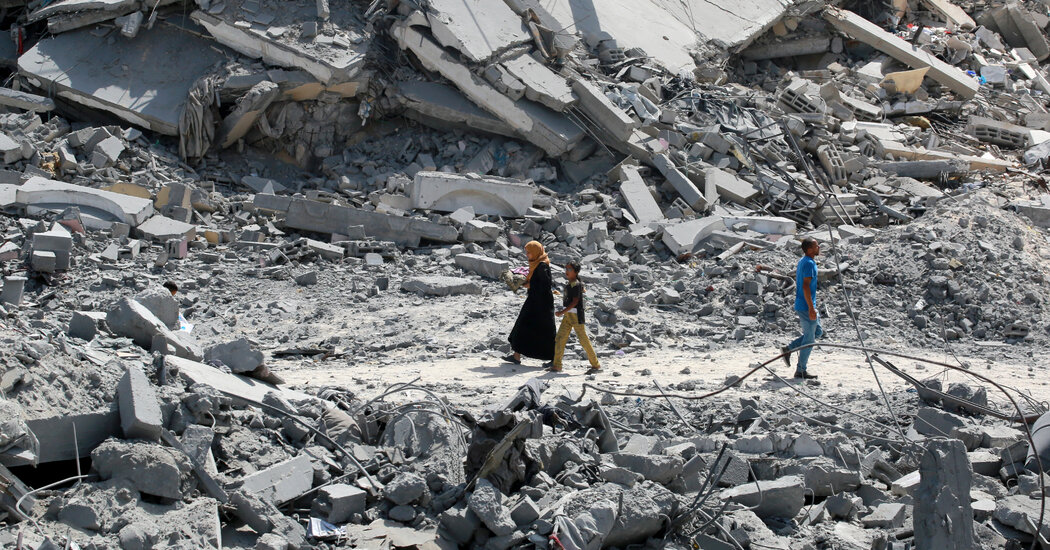Israeli ministers were set to meet on Thursday evening to discuss Hamas’s response to a new proposal for a truce in Gaza and the release of hostages, even as an unusually large rocket and drone attack by Hezbollah, the Lebanese armed group, sparked wildfires on the country’s northern border.
Prime Minister Benjamin Netanyahu of Israel greenlit a new delegation of negotiators to engage in more in-depth talks with mediators following Hamas’s response, said an Israeli official who circulated a written statement to reporters on condition of anonymity. Such meetings have been rare for the past several weeks as negotiations ground to a halt in June.
Regional mediators — mostly Qatar and Egypt — have sought to revive dormant talks about a cease-fire in Gaza after nearly nine months of war. The Biden administration hopes that a truce in Gaza will allow Israel and Hezbollah, which has been firing at Israel in solidarity with Hamas, to reach a diplomatic settlement as well.
The discussions are based on a three-stage framework deal publicized by President Biden in late May and endorsed by the United Nations Security Council. Last week, Qatari mediators sent Hamas possible amendments in an effort to bridge gaps between the two sides. Hamas had demanded stronger guarantees to limit Israel’s ability to call off the agreement and return to battle before the second stage of the agreement, which would see a permanent cease-fire.
On Wednesday, Hamas announced that it had “exchanged some ideas” with the mediators on the cease-fire deal, saying it was “dealing positively” with ongoing talks on the matter. They also submitted a formal response that was ultimately transferred to Israel for examination, the Israeli government said.
A second Israeli official, speaking on condition of anonymity because they were not authorized to speak publicly, said on Wednesday night that wide gaps between the sides remained but that Hamas’s response left potential to move forward in the talks. The official declined to offer further details.
For months, Israel and Hamas, alongside Qatar, Egypt and the United States, have held indirect talks over the potential cease-fire, which called for a three-stage truce in Gaza and the release of the remaining 120 living and dead hostages still held there. However, significant differences remained on major issues, and the talks had been largely at a standstill since June.
The main stumbling blocks are related to a fundamental dispute: Hamas wants guarantees that the deal would lead to an end to the war and a full withdrawal of Israeli forces, while Israel has vowed to keep fighting until Hamas is destroyed and is also seeking postwar security control in Gaza.
In Israel, some influential members of Prime Minister Benjamin Netanyahu’s coalition government have already expressed opposition to a potential deal with Hamas.
“Now is not the time to stop, it is entirely the opposite: It is the time to bring in more forces and increase our military pressure,” Bezalel Smotrich, the country’s far-right finance minister, said on Tuesday. “It would be absurd if we were stop just a moment before success — the end, total victory over Hamas.”
On Thursday, Hezbollah launched one of the largest attacks on northern Israel since the war began almost nine months ago, triggering air-raid sirens across the area for over an hour and sending thousands running for fortified shelters. Roughly 200 rockets and mortars and 20 drones were launched into northern Israel, according to the Israeli military.
Since the Hamas-led attack on Oct. 7, Hezbollah, the politically powerful Lebanese armed group, has repeatedly attacked northern Israel in solidarity with Hamas, prompting Israeli strikes in Lebanon. More than 150,000 people on both sides of the Israel-Lebanon border have fled, with little idea of when they might return home.
Since October, more than 80 Lebanese civilians and 11 civilians in Israel have been killed in the fighting between Israel and militant groups in Lebanon, according to U.N. and Israeli government statistics. More than 300 Hezbollah fighters have been killed, according to the group, as have at least 17 Israeli troops, according to the Israeli government.
Hezbollah said Thursday’s barrage was partly a response to Israel’s assassination of a senior Hezbollah military commander the previous day in the region of Tyre in southern Lebanon. But the Hezbollah munitions were mostly fired on border areas, avoiding a broader attack on Israel’s heartland that would most likely have provoked a more severe response.
“The series of responses is still ongoing in these moments and will continue, targeting installations that the enemy never believed would be struck,” Hashem Safieddine, a senior Hezbollah official, said in a televised speech. “This front will remain ablaze, strong and become only stronger.”
Hezbollah has said its forces will not stop their attacks until Israel ends its military campaign in Gaza. At the same time, Israeli officials have voiced increasingly bellicose threats of a potential offensive in Lebanon to push Hezbollah away from the border.
